So I've tumbled head over heels into the world of fiber preparation.
I wasn't really ready, I know I wasn't. But I wanted a Cormo fleece because I'm so in love with the fiber itself lately. And I knew Brooke could get me one, a local one, a fleece from a sheep with a name, and then Kira kindly brought it to my sister's place, which is how I ended up with this much awesome in my house.
This is from Karo (like the syrup! Five pounds of sweetness!):
Look at that crimp! Could you die? That's what it looked like when I peeked into the bag.
I did a bit of rudimentary research online (thanks, Ravelry!) and decided to go for the quick-and-dirty top-loader method of washing. I got the water in the washer as hot as I could (by turning off the cold tap entirely), added some liquid dish soap, and threw some fiber in to soak. (This isn't actually that much; I wasn't going to risk much of it, I swear. But it looks like a lot.)
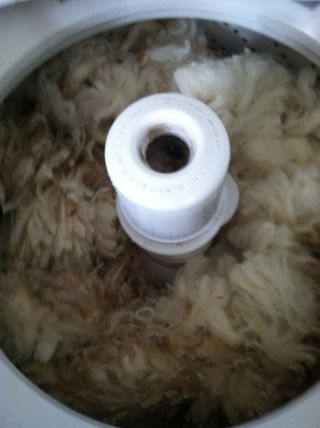
Oh, GOD, was it disgusting-looking in there. It got worse the wetter it got:
That's poop, people. Okay, not much poop because it was beautifully skirted, but there's oil and vegetable matter and dirt from the field. Lemme ask you this: but do I want to re-skirt it before I wash more? I do plan on getting lingerie bags and using them instead of letting the fleece roam free in the washer. I didn't agitate it (of course), I just spun the water out for all five (FIVE!) soaks, but I was completely convinced I'd felted the whole thing, because you know what? When you pull wet fleece out of a washer, it's flat and thin and looks irreparably felted. I asked Twitter, which told me it was normal to think that and to stop panicking.
And it WASN'T felted, as you can see here on my uber-classy drying rack.
Uncarded, just dried Cormo. Almost clean. Ish.
So: there's still a little dirt on some of the tips. Is this normal? Should I have clipped ALL the darker bits out before washing?
And for something like this, how do you prepare it? I bought two dog combs, figuring worst-case scenario we'd have better-groomed dogs, and I've decided that making rolags is what I like best at this point:
I think the way I washed it caused me to lose too much of the lock definition to flick it, so carding it what I should do, right? (Ignore the little neps you see. I think that's because I over-carded that bit. As in, I carded it about forty times instead of five. I'm getting better at the motion.)
And here's the first bit, spun up:
I'm thinking three-ply. Oh, yeah.
(For those of you who warned me against starting with Cormo, bless you. Yep, I see what you mean. But you know me, I like to jump in with both feet until I'm underwater and fighting my way back up to the surface. It makes breaking into daylight and fresh air that much sweeter.)
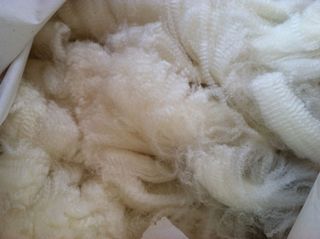
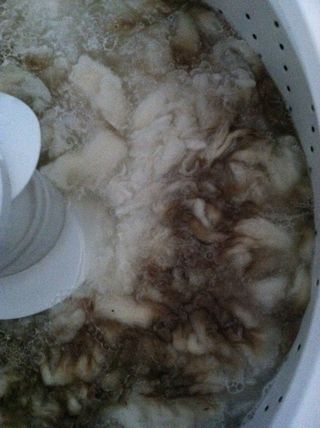

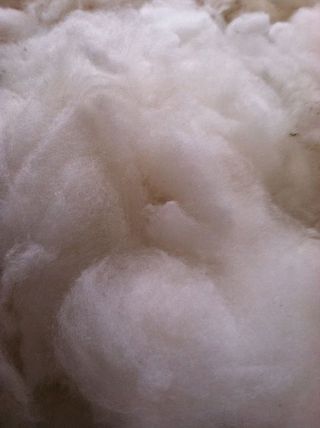
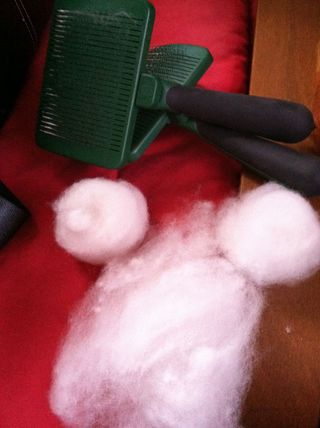
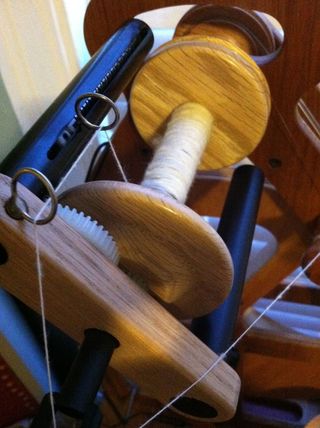
Good Luck and Godspeed. That’s all I can say. That and, please, do ALL the carding and prep before you spin any significant amount. Do you really wanted to start that card/spin cycle?
It’s a slippery slippery slope – but it looks like so much fun. So far I’ve only played with fibre prep in a spinning class, everything I’ve spun was ready carded, but I’ll admit there’s a certain pull in knowing the name of the sheep that gave you the sweater. Are you going to dye it or stick with the natural?
I just read your memoir this weekend, and I found it funny and touching. As a newbie knitter (I’m 51), a lot of the yarn stuff you wrote was like algebra to me, and when you got into the spinning it was trig. This post is calculus…
BUT, I’ve been recommending your book to all my “Dose of Fiber” friends (that’s my lil’ knitting/crocheting group) and beyond!
I have a boy in my class (I teach4th grade) who knits, and I’m sharing your 911 story with him. His dad makes fun of his knitting, but the boy is upset over his parents divorce, so he needs to know about your book.
This is a less than eloquent comment, as I’m rushed, but I hope to blog about your book soon.
Ellie from Illinois
It looks as if you are doing a fabulous job to me. 🙂 I have some tools I’d be happy to lend to you (drum carder, bigger cards..) that could make processing more efficient, but logistically it might be a bit tough to get them to you – I’ll be at Stitches briefly but I’m heading out of town Saturday afternoon.
So if you’re up for that let me know and we’ll figure something out – but you’re doing beautifully on your own!
XO
I lay the fleece out and do a skirting of the really dirty bits. Then I soak the fleece for several hours or up to a day in a huge bucket outside a number of times. The sun warms the water, and the trees enjoy the sludge. I dump the fleece and water onto a piece of screen cloth, roll the screen and gently squeeze out most the of water. This method keeps the worst of the sludge out of your washing machine. The only other thing I would recommend is that you use mesh bags to contain the fleece so that it is easier to handle in the washing machine.
OMG’dess, I’m so impressed. It seems like all the world around me is getting into their own fiber prep. I am not headed that way yet, though I do plan to buy a fleece in the coming year. I’ll have some kind person/company prep it for me, I think, because I have enough unclean junk laying around this house, + 2 poodles who don’t get combed nearly often enough.
Cormo…a cross between Corriedale (which I love to spin) and Merino (which I love considerably less) has me wondering which of its parents it takes after. How much yarn do you think you’ll get out of it?
It’s not poop. The brown water is because that sheep wore the same clothes and lived outside for 6 months or more. Your fleece was well skirted and exceptionally clean. There was no poop. Also, sheep poop doesn’t dissolve well in hot water. It’s just dirt.
I have 2 years, soon to be 3, of alpaca fleeces that are in desperate need of prep before I can spin them. Watch your mailbox…… 🙂
I have Schact handcards you could borrow if the dog brushes are causing your neps, or Verb rents out a drumcarder if you want to get it done quickly.
Just brush the dogs intermittently while you’re working, and you’ll have art yarn! Bonus: no one will be able to tell when you have pet hair on your sweater, because there will be pet hair in your sweater.
Oh yeah you are a fanatic and you’re taking me with you!! Looks like fun!
Hey I just got your new book and was wondering if you’re going to be at stitches and if you’ll sign it if I run into you?
Grace
LOL. All these offers for the loan of a drum carder? Pay attention and don’t lose track of them. Ask me how I know.
Have fun!
I agree with the “cold soak” method. Water temp doesn’t matter too much for the first long soak (overnight is fine, a week won’t hurt (oops, forgot about that bin…). Just put it in plenty of water. Sheep secretions have a mix of fat and salt that actually form a little bit of soap and help get the worst of the dirt off.
Lingerie bags are a bit small. Get yourself some old mesh curtains and sew some flat bags about the size of the bottom of your laundry tub. Put a “fold lock top” on them (like a sandwich bag or a closing pillow case) about 6″ deep.
Once you’ve cold soaked you can dry them to wash later, or wash them right away. You can always put wool in hotter water than it’s been in with no effect, but cooler will cause the scales to close up resulting in felt. If you want to protect your washer, wash the fleece in the laundry tub, drain the dirty soapy water, and rinse once. Then spin out the rinse water. Rinse again once or twice spinning the water out after each rinse.
As to spinning it, the Interweave Press DVD by Margaret Stove “Spinning for Lace” has really good instruction for dealing with merino and merino crosses like Cormo. Those really elastic fibres require a bit of technique to control and harness the elasticity. She also talks about washing techniques and dealing with the dirty tips.
Guess I’m not the first, but I have some vintage wool ccarders in good shape you can have. For some reason, I seem to be a wool carder magnet.
I am NOT a spinner and surely never will be.
But that sweet pile of fluff on top of the drying rack? Looks so sweet, soft and floofy.
If my left hand still worked, I would be tempted to try spinning again. I tried with a drop spindle years ago, and decided the world already has so many pretty yarns I didn’t need to add to the pile ;-).
The Yarn Harlot had a great tutorial on washing fleeces lock by lock: http://www.yarnharlot.ca/blog/archives/2007/08/28/this_is_the_way_we_wash_our_fleece.html
That Cormo looks sweet enough that you might want to keep track of the lock structure, if you’re willing to go through the trouble. Also, please take advantage of one of your other readers’ offers of real wool cards. Good cards are wonderful tools and will never fail you. Or, you could spin right from a nicely flicked lock.
The world’s your fleecy oyster now, girl!
I am enamored of cormo. Seriously. Now I miss my toploader because I have been tempted to try this.
I’m currently processing a Leicester Longwool and one way to keep the crimp definition is to just use on brush and open up the ends lock by lock.
Here is the post
http://radbitdyer.blogspot.com/2012/03/fleece.html